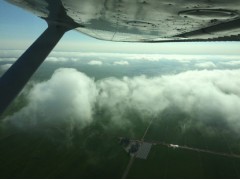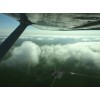Obtaining your insturment rating adds much utility to your pilot certificate. Flying through a low ceiling such as a 500 ft. overcast layer will no longer be problem in getting you to your destination.
You will also be a safer pilot, have more pecisicion in your flying abilities, and have more confidence especially in the Air Traffic Control system.
Whether you are looking to start your instrument rating or looking for a finish-up program, we can assist in achieving your goal. We have Cessna 172s available to rent for $150 per hour at Lincoln Regional Airport. They are IFR certified with two nav/com radios, DME, and marker beacon receiver.
Instrument Rating Syllabus:
Ground Training:
Aircraft Systems - Navigation equipment, pitot/static and gyro instruments
Basic attitude instrument flying - Different instrument scan techniques
Approaches - Interperting Instrument Approach Procedure (IAP) charts, briefing approach methods
Cross country flight planning - Weather, Enroute charts, regulations pertaining to IFR as well as lost comms. procedures
Flight Training:
Basic attitude instrument flying - You need good fundamental skills of flying instruments before adding more workload (ie: flying approaches, holds, etc)
Unusual Attitude Recoveries - Full and partial panel
Navigation - Tracking VORs, DME arcs, GPS/RNAV
ATC Clearances - obtaining an IFR clearance, void times, etc.
Holds - Holding pattern entries, leg lengths, timing and holding speeds
Approaches - Non-precision and precision approaches, missed approaches, and circle to land
Experience requirements:
50 hours of cross country time as PIC (10 hours in airplanes)
40 hours actual or simulated instrument conditions
15 hours actual or simulated instrument training with an Instrument Instructor involving:
1 cross country under instrument flight rules that includes:
A flight of 250 nautical miles along airways or by directed routing from an air traffic control facility
An instrument approach at each airport; and
Three different kinds of approaches with the use of navigation systems.
3 hours dual flight training in preparation for the practical test within the preceding 2 calendar months





